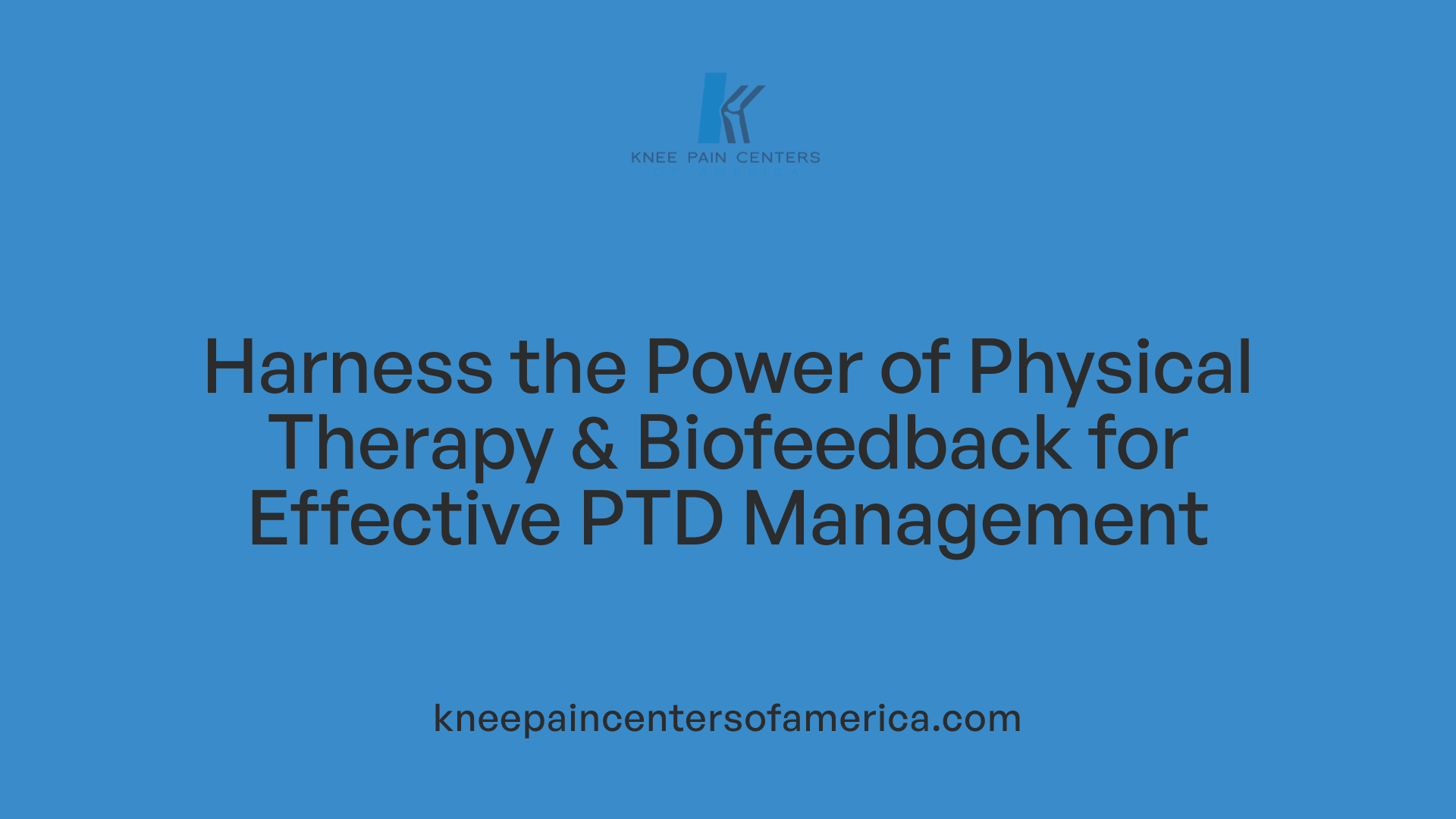Understanding Patellar Tracking Disorder and Its Impact
Patellar Tracking Disorder (PTD) is a common cause of knee pain characterized by the kneecap's improper movement within the trochlear groove, leading to discomfort, swelling, and functional limitations. Affecting a notable portion of active individuals, particularly adolescents and females, PTD can progress to osteoarthritis if untreated. This article explores effective exercise therapies and comprehensive management strategies to address PTD, emphasizing non-surgical interventions and their role in restoring knee function and reducing pain.
The Nature and Causes of Patellar Tracking Disorder
What is Patellar Tracking Disorder?
Patellar Tracking Disorder (PTD) occurs when the kneecap (patella) fails to glide smoothly within the trochlear groove of the femur. This improper movement can cause pain, swelling, and reduced knee function, impairing daily activities and athletic performance. PTD commonly results from biomechanical abnormalities affecting knee joint alignment and motion.
Biomechanical Causes
Several factors contribute to the abnormal tracking of the patella. These include a shallow trochlear groove that inadequately guides the kneecap, an increased Q-angle which alters the pull direction of the quadriceps muscle, and dynamic valgus caused by excessive hip internal rotation. Muscle imbalances, particularly weakness or delayed activation in the quadriceps muscles and hip abductors, also disrupt normal patellar tracking.
Prevalence and Risk Factors
PTD affects about 15-25% of active adolescents and is more common in females and individuals with joint hypermobility. If left untreated, the condition can progress over time and increase the risk of developing osteoarthritis of the knee. Early identification and management of there biomechanical and muscular factors are essential to prevent long-term complications associated with PTD.
Diagnosis and Importance of Tailored Exercise Programs

How is Patellar Tracking Disorder diagnosed and managed?
Patellar Tracking Disorder (PTD) diagnosis primarily relies on a detailed clinical evaluation. Healthcare professionals assess patient history alongside physical examination, focusing on the kneecap's movement within the trochlear groove, areas of tenderness, range of motion, and muscle flexibility. Key indicators include pain around the patella during activities such as squatting or prolonged sitting, and signs of maltracking identified through functional tests.
Accurate diagnosis is fundamental because it directs the creation of a personalized rehabilitation plan. Understanding each patient's unique biomechanical factors, such as Q-angle abnormalities or hip muscle imbalances, allows therapists to tailor exercises that address specific weaknesses or alignment issues.
Exercise programs are carefully crafted by professionals to fit the individual's condition, with an emphasis on strengthening the quadriceps—particularly the vastus medialis oblique (VMO)—and enhancing hip stability. Progression in exercise intensity and volume is gradual, respecting the patient's pain threshold to avoid exacerbating symptoms. This personalized, stepwise approach supports tissue healing, improved knee function, and reduces the risk of developing more severe complications like osteoarthritis.
By combining comprehensive clinical assessment with tailored physical therapy, most PTD cases can achieve significant improvement through nonsurgical means, highlighting the importance of expert-guided rehabilitation for successful management.
Exercise Therapies: Strengthening Quadriceps and Hip Muscles

What are effective exercises for managing Patellar Tracking Disorder?
Patellar Tracking Disorder (PTD) often arises from imbalances in muscle strength around the knee and hip, making targeted strengthening exercises essential. Quadriceps strengthening, particularly focusing on the vastus medialis obliquus (VMO), plays a central role in improving patellar alignment and function.
Quadriceps strengthening exercises
Static quadriceps contractions are a foundational exercise where the knee is extended and held steady to activate the VMO. Terminal knee extensions, which involve extending the knee against resistance from about 30 degrees of flexion to full extension, also effectively strengthen the quadriceps and enhance patellar tracking.
Hip strengthening importance
Muscle imbalances at the hip, such as weakness of the hip abductors and external rotators, contribute to knee malalignment and tracking issues. Strengthening these muscles stabilizes the pelvis and reduces dynamic valgus, improving knee mechanics.
Specific exercises such as terminal knee extensions and clamshells
Clamshell exercises target the hip abductors and external rotators by having the individual lie on their side and lift the top knee while keeping feet together. Side-lying leg lifts with a pillow help further engage hip abductors. Step-ups and wall squats complement these by strengthening quadriceps while encouraging proper patellar pathway.
Together, this combination of quadriceps and hip muscle exercises forms a comprehensive program aimed at correcting biomechanical factors underlying PTD. When performed under professional guidance with gradual progressions and pain monitoring, these exercises significantly improve symptoms and function.
Enhancing Flexibility and Mobility Through Stretching and Manual Therapy
How do flexibility exercises and manual therapy support PTD management?
Stretching plays a crucial role in managing patellar tracking disorder (PTD) by targeting key muscle groups around the knee and hip. Exercises that focus on the hip flexors, quadriceps, hamstrings, and calves help reduce muscle tightness that can pull the kneecap out of its proper alignment. This improved flexibility contributes to smoother patellar movement within the trochlear groove, easing pain and preventing worsening symptoms.
Manual therapy techniques complement stretching by directly enhancing patellar mobility. Medial patellar glides and soft tissue mobilizations are often used to increase the kneecap's range of motion, reduce stiffness, and alleviate discomfort. These hands-on treatments can be tailored by physical therapists to meet individual needs.
Foam rolling the iliotibial (IT) band and related tissues is another effective strategy. By reducing tension in the IT band, foam rolling helps decrease lateral forces on the patella, further supporting proper tracking and reducing knee irritation. Incorporating these approaches encourages tissue healing, facilitates better movement mechanics, and contributes to overall improvement in PTD symptoms.
Pain Management and Monitoring During Rehabilitation Exercises
How should pain be managed during PTD exercises?
Managing pain effectively during rehabilitation exercises for patellar tracking disorder (PTD) is essential to promote healing without exacerbating symptoms. Patients are advised to keep their discomfort within a moderate range, typically rated between 0 and 5 on a 10-point pain scale. Should pain exceed this threshold, the intensity of exercises or the number of repetitions should be reduced accordingly.
Adjusting exercise intensity
Exercise programs must be gradually progressed, allowing muscles and tissues time to adapt and strengthen. Starting with low repetitions and sets, individuals can slowly increase workload while monitoring knee pain. This approach prevents overloading the joint, which could worsen inflammation or tracking issues.
Role of rest and activity modification
During times of symptom flare-ups, rest and activity modification play a critical role in pain relief. Temporarily reducing activities that place excessive stress on the knee helps decrease swelling and discomfort. Patients are encouraged to listen closely to their bodies and avoid pushing through sharp or worsening pain.
By integrating these strategies—pain threshold awareness, careful exercise progression, and sensible rest—patients can optimize rehabilitation outcomes and support long-term knee function improvement.
Role of Physical Therapy and Biofeedback in Managing PTD

What role does physical therapy play in managing Patellar Tracking Disorder?
Physical therapy is fundamental in treating Patellar Tracking Disorder (PTD) by addressing muscle imbalances and biomechanical factors that disrupt normal kneecap motion. It includes strengthening exercises especially focused on the vastus medialis obliquus (VMO), gluteal muscles, and hips to enhance joint stability and correct tracking.
Therapists utilize manual therapy techniques such as medial patellar glides and soft tissue mobilizations, which help improve patellar mobility and reduce kneecap maltracking.
Use of biofeedback for muscle activation
Biofeedback is an effective tool used in physical therapy for PTD that helps patients consciously activate specific muscles, particularly those that are weak or poorly coordinated like the VMO. This technique facilitates better muscle recruitment and timing, contributing to improved patellar control during movement.
Functional retraining exercises
Functional exercises complement strengthening efforts by retraining movement patterns and improving knee control in dynamic activities. Examples include step-downs, lateral band walks, and single-leg deadlifts. These exercises focus on enhancing core and hip stability while promoting neuromuscular coordination essential to preventing abnormal patellar tracking.
Physical therapy thus combines muscle activation, manual techniques, and movement retraining to reduce symptoms, support tissue healing, and restore functional knee mechanics critical for managing and recovering from PTD.
Supportive Devices: Taping and Bracing for Patellar Stability

What types of supportive devices are used?
Supportive devices commonly used for patellar tracking disorder include McConnell taping and specialized patellar braces. McConnell taping involves applying rigid tape strips to guide the patella into a more optimal position, aiming to reduce maltracking during movement. Patellar braces provide stabilization by applying targeted pressure and support around the knee joint.
How effective are taping and bracing?
While taping and bracing alone are unlikely to produce better outcomes than physical therapy, they serve as valuable adjuncts. These devices can temporarily correct patellar alignment and reduce symptoms such as pain and instability during activities. They are most effective when combined with exercise programs that address underlying muscle imbalances and biomechanical factors.
How should taping and bracing be used during rehabilitation?
Taping and bracing are typically employed during physical activity to support the knee and prevent symptom flare-ups. They should be used alongside a tailored rehabilitation plan developed by healthcare professionals. The goal is to facilitate safe movement while the muscles around the knee and hip are strengthened to provide long-term stability. Regular reassessment ensures the devices remain beneficial and do not mask worsening symptoms.
Supportive devices like taping and bracing offer symptomatic relief and mechanical correction, enhancing the effects of conservative treatment approaches for patellar tracking disorder.
When Surgical Intervention Becomes Necessary
Criteria for Surgery
Surgical intervention for patellar tracking disorder (PTD) is typically considered only after 3 to 6 months of unsuccessful conservative management. This includes lack of improvement despite targeted physiotherapy, bracing, taping, and other nonsurgical treatments. For knee osteoarthritis, surgery is usually reserved for cases where symptom severity and functional impairment persist after 6 to 12 months of conservative care.
Types of Surgical Procedures
Common surgical options for PTD include lateral retinacular release, which involves cutting tight soft tissues to relieve patellar maltracking. Another procedure is tibial tubercle transfer, where the bony attachment of the patellar tendon is repositioned to improve patellar alignment and tracking. These surgeries aim to restore proper patellar mechanics and reduce pain.
Recovery Timelines Post-Surgery
Recovery time after surgery depends on the complexity and severity of the condition. Mild cases may recover within 4 to 8 weeks, while moderate cases could require 8 to 12 weeks. Post-surgical recovery generally spans 4 to 6 months to regain full function and strength. Rehabilitation during this period is crucial to optimize outcomes and prevent recurrence of symptoms.
Integrating Aerobic and Low-Impact Exercises for Long-Term Knee Health

What aerobic activities are recommended for managing patellofemoral pain and knee osteoarthritis?
Managing patellofemoral pain syndrome (PFPS) and knee osteoarthritis effectively involves choosing aerobic activities that minimize joint stress. Recommended exercises include cycling, swimming, elliptical training, rowing, and walking. These activities provide cardiovascular benefits and help maintain knee muscle strength without placing excessive load on the joints.
Cycling, in particular, is beneficial when performed with a high cadence (80-90 rpm), low resistance, and proper bike fitting. This low-impact activity strengthens the quadriceps and surrounding muscles while promoting smooth patellar tracking.
Conversely, high-impact activities such as deep squats, running, high-impact aerobics, and jumping are best avoided during acute symptom phases. These exercises can increase joint loading and worsen knee pain.
Exercise progression and adherence
For long-term improvements, gradual progression in exercise intensity, repetitions, and sets is essential. Patients should start at a comfortable level and build up slowly to avoid aggravating symptoms. Monitoring pain levels during exercise—keeping discomfort within a moderate range of 0-5 out of 10—and adjusting activity accordingly help prevent setbacks.
Adhering to tailored exercise programs developed by healthcare professionals improves outcomes by addressing individual biomechanics and pain thresholds. Regular aerobic activity combined with strengthening and stretching exercises not only supports tissue healing but also enhances functional knee movement.
Overall, incorporating these joint-friendly aerobic exercises alongside a structured rehabilitation plan offers an effective approach to managing patellofemoral pain and osteoarthritis, promoting long-lasting knee health and mobility.
Overall Management and Expected Outcomes for Patellar Tracking Disorder Exercises
What are the expected outcomes and management strategies for Patellar Tracking Disorder?
Management of Patellar Tracking Disorder (PTD) focuses on a comprehensive, long-term rehabilitation approach that combines rest, exercise, manual therapy, and activity modification. Most patients experience meaningful improvement within 4 to 8 weeks, especially when following a tailored exercise program developed by healthcare professionals. This program typically includes strengthening of the quadriceps (notably the vastus medialis oblique), hip muscles, and core stability exercises, alongside flexibility routines and techniques like patellar mobilization or taping.
Long-term rehabilitation approaches
Effective rehabilitation requires gradual progression in exercise repetitions and intensity to build strength and restore smooth patellar movement without exacerbating symptoms. Patients are educated to monitor pain levels—maintaining discomfort within a moderate range—and to listen carefully to their bodies. Physical therapy may also incorporate biofeedback for better muscle activation and manual therapies such as medial patellar glides to improve joint mobility.
Expected recovery timelines
The expected recovery timeline varies by severity; mild to moderate cases generally improve over 4 to 8 weeks, while more severe or refractory cases may take several months. For individuals undergoing surgery (typically after 3 to 6 months of unsuccessful conservative treatment), recovery can extend from 4 to 6 months. Adhering to professional guidance throughout this period is crucial for optimal outcomes.
Importance of professional guidance and patient education
Professional supervision ensures correct diagnosis and customized exercise prescriptions, reducing the risk of worsening symptoms or premature activity resumption. Patient education is integral, emphasizing gradual progression, pain monitoring, and body awareness. This education also helps improve compliance and prevents progression to complications like osteoarthritis. Regular follow-ups allow objective monitoring of quadriceps strength, patellar tracking, and symptom changes, guiding stepwise return to activity.
In summary, targeted exercise combined with rest, manual therapy, and education forms the cornerstone for successful long-term management of PTD, leading to improved knee function, reduced pain, and a lower risk of future joint issues.
Promoting Recovery and Preventing Progression through Exercise
Properly designed and supervised exercise programs remain the cornerstone of managing Patellar Tracking Disorder. Through targeted strengthening, flexibility training, and functional retraining, most patients can achieve significant symptom relief and improved knee function without surgery. Integrating supportive strategies such as manual therapy, taping, and low-impact aerobic activities further enhances recovery. Early diagnosis, individualized rehabilitation, and patient adherence are critical to preventing progression to osteoarthritis and ensuring long-term knee health.
References